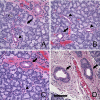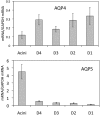Duct system of the rabbit lacrimal gland: structural characteristics and role in lacrimal secretion
- PMID: 20107177
- PMCID: PMC2891459
- DOI: 10.1167/iovs.09-4687
Duct system of the rabbit lacrimal gland: structural characteristics and role in lacrimal secretion
Abstract
Purpose: To develop a nomenclature for the lacrimal duct system in the rabbit, based on the anatomic and structural characteristics of each duct segment, and to provide RT-PCR and immunofluorescence data to support the notion that the duct system plays important roles in lacrimal function.
Methods: Paraffin-embedded lacrimal glands (LGs) were stained with hematoxylin and eosin (H&E) and evaluated with a stereomicroscope. Cryosections of LG were stained with cresyl violet, and acinar cells and ductal epithelial cells were isolated from each duct segment by laser capture microdissection (LCM). mRNA levels from these cells were analyzed by real-time RT-PCR. Standard protocol was followed for immunofluorescence detection of ionic transporters.
Results: The lacrimal duct system was divided into six segments on the basis of morphologic characteristics: the intercalated, intralobular, interlobular, intralobar, interlobar, and main excretory ducts. Although the morphologic features change incrementally along the entire duct system, the gene expression of ionic transporters and aquaporins, including AE3, AQP4, AQP5, CFTR, ClC2gamma, KCC1, NHE1, NKAalpha1, NKAbeta1, NKAbeta2, NKAbeta3, and NKCC1 varied greatly among duct segments. Immunofluorescence results were generally in accordance with the abundance of mRNAs along the acinus-duct axis.
Conclusions: Most LG research has focused on the acinar cells, with relatively little attention being paid to the lacrimal ducts. The lack of knowledge regarding the lacrimal ducts was so profound that a precise nomenclature had not been established for the duct system. The present data establish a nomenclature for each segment of the lacrimal duct system and provide evidence that ducts play critical roles in lacrimal secretion.
Figures








Similar articles
-
Changes of the ocular surface and aquaporins in the lacrimal glands of rabbits during pregnancy.Mol Vis. 2011;17:2847-55. Epub 2011 Nov 9. Mol Vis. 2011. PMID: 22128232 Free PMC article.
-
Changes of aquaporins in the lacrimal glands of a rabbit model of Sjögren's syndrome.Curr Eye Res. 2011 Jun;36(6):571-8. doi: 10.3109/02713683.2011.574330. Epub 2011 Apr 27. Curr Eye Res. 2011. PMID: 21524183 Free PMC article.
-
Gene expression in rat lacrimal gland duct cells collected using laser capture microdissection: evidence for K+ secretion by duct cells.Invest Ophthalmol Vis Sci. 2006 May;47(5):1876-85. doi: 10.1167/iovs.05-0363. Invest Ophthalmol Vis Sci. 2006. PMID: 16638994
-
New insight into lacrimal gland function: Role of the duct epithelium in tear secretion.Ocul Surf. 2020 Oct;18(4):595-603. doi: 10.1016/j.jtos.2020.07.002. Epub 2020 Jul 21. Ocul Surf. 2020. PMID: 32707335 Review.
-
[Anatomy and physiology of efferent tear ducts].Ophthalmologe. 2008 Apr;105(4):339-45. doi: 10.1007/s00347-008-1735-x. Ophthalmologe. 2008. PMID: 18350298 Review. German.
Cited by
-
Potentially pathogenic immune cells and networks in apparently healthy lacrimal glands.Ocul Surf. 2015 Jan;13(1):47-81. doi: 10.1016/j.jtos.2014.06.003. Epub 2014 Nov 6. Ocul Surf. 2015. PMID: 25557346 Free PMC article.
-
Characterization of Na+-K+-2Cl- Cotransporter Activity in Rabbit Lacrimal Gland Duct Cells.Invest Ophthalmol Vis Sci. 2016 Jul 1;57(8):3828-35. doi: 10.1167/iovs.15-18462. Invest Ophthalmol Vis Sci. 2016. PMID: 27438543 Free PMC article.
-
Changes of the ocular surface and aquaporins in the lacrimal glands of rabbits during pregnancy.Mol Vis. 2011;17:2847-55. Epub 2011 Nov 9. Mol Vis. 2011. PMID: 22128232 Free PMC article.
-
Not all lacrimal epithelial cells are created equal-heterogeneity of the rabbit lacrimal gland and differential secretion.Curr Eye Res. 2011 Nov;36(11):971-8. doi: 10.3109/02713683.2011.602814. Curr Eye Res. 2011. PMID: 21999223 Free PMC article.
-
ENaC in the Rabbit Lacrimal Gland and its Changes During Sjögren Syndrome and Pregnancy.Eye Contact Lens. 2015 Sep;41(5):297-303. doi: 10.1097/ICL.0000000000000123. Eye Contact Lens. 2015. PMID: 25828511 Free PMC article.
References
-
- Hisada M, Botelho SY. Membrane potentials of in situ lacrimal gland in the cat. Am J Physiol 1968;214:1262–1267 - PubMed
-
- Raina S, Preston GM, Guggino WB, Agre P. Molecular cloning and characterization of an aquaporin cDNA from salivary, lacrimal, and respiratory tissues. J Biol Chem 1995;270:1908–1912 - PubMed
-
- Hand A, Coleman R, Mazariegos MR, Lustmann J, Lotti LV. Endocytosis of proteins by salivary gland duct cells. J Dent Res 1987;66:412–419 - PubMed
Publication types
MeSH terms
Substances
Grants and funding
LinkOut - more resources
Full Text Sources
Medical
Miscellaneous

